Abstract
The article presents the rediscovery and analysis of important documents concerning the early history of the Museo Egizio in Turin, which are currently held in the State Archive in Turin. The study of these papers shed light on a crucial phase in the history of the museum, allowing the author to retrace features of the display of the statue gallery of the Museo Egizio in the 1850s.
This article analyses unpublished documents dating to the first half of the 19th century and concerning the early history of the Museo Egizio in Turin.1 These documents are held, along with about two hundred more, in the State Archive in Turin since 2009, where they were deposited by the Soprintendenza per i Beni Archeologici del Piemonte e del Museo di Antichità Egizie.2
My study of these documents, combined with an analysis of published documents and drawings, cross-correlated with the information of the museum’s database and a study of its objects, shed new light on the history of the Museo Egizio. More specifically, my identification of some archival records allowed me to reconstruct how the Museo Egizio’s statue gallery (“Statuario”, currently Gallery 14) was displayed in the 1850s. The identification of the entire cluster of objects displayed in the Statuario in the 1850s and of their precise location is currently in progress. A virtual reconstruction of the Statuario based on this research is planned.
The archival research
In 2018, while doing research in the main archives and libraries in Turin,3 I discovered in the State Archive a folder bearing the title “Inventario minuto delle Antichità Egizie. Monumenti al Pian Terreno” (Pl. 1).4 It contains, among others,5 a document headed “Situazione dei monumenti egiziani delle sale al pian terreno. I numeri sono quelli dati a ciascun monumento nel catalogo provvisorio”6 (henceforth “Situazione”) (Pls. 2–6).
The “Situazione” consists of four pages (on two sheets folded in the middle) bearing two lists of numbers7 (Pls. 3–5), and a plan on two sheets folded in the middle (Pl. 6).8 The latter shows small squares and rectangles of different sizes indicating Egyptian items displayed on the ground floor rooms – undoubtedly the ground floor rooms of the historical and current statue gallery of the Museo Egizio (Statuario) on the ground floor of the Palazzo dell’Accademia delle Scienze, based both on the shape of the rooms and the fact that the documents
The lists appear to be lists of concordances:
- List 1 is on two columns labelled C and S (Pl. 3);
- List 2 is on three columns: C, S, and a third unlabelled column consisting of a letter followed by a number10 (Pls. 4–5).
On the last page of List 2 are the following thirteen handwritten lines: (Pl. 5)
This information is thus the key to reading the lists, telling us that they refer to the plan and provide indications about the objects’ location. They were evidently completely understandable by the author and by his contemporaries, but their meaning is not immediately intelligible to a modern reader. More precisely, the legend mentions some elements whose meaning was unknown at the beginning of the investigation such as the “catalogo provvisorio” (provisional catalogue) and the “entrata di mezzanotte” (midnight entrance). Thus, the first step in the research process was to clearly interpret these elements.
The starting point was to identify the “entrata di mezzanotte”, as the legend tells the reader that the “Situazione” – that is the disposition of the objects – starts from there.
List 1 helped in locating the “entrata di mezzanotte” as it indicates that number 19 in the plan corresponds to number 1 of “Situazione” — and thus corresponds to the “entrata di mezzanotte” — 12 number 121 in the plan corresponds to number 2 of “Situazione”, number 44 in the plan to number 3 of “Situazione”, number 122 in the plan to number 4 of “Situazione” and so on and so forth counterclockwise (Pls. 3, 6).
Then, I searched for other documents in order to identify the “catalogo provvisorio”. I derived information in this regard from an 1851 engraving published in 1852 in a city guide with the title “Una Sala del Museo Egizio” (Fig. 1).
Engraving of a Museo Egizio room made in 1851. From Stefani and Mondo, Torino e Suoi Dintorni. Guida Storico-Artistica, Amministrativa e Commerciale, Torino 1852, p. 168.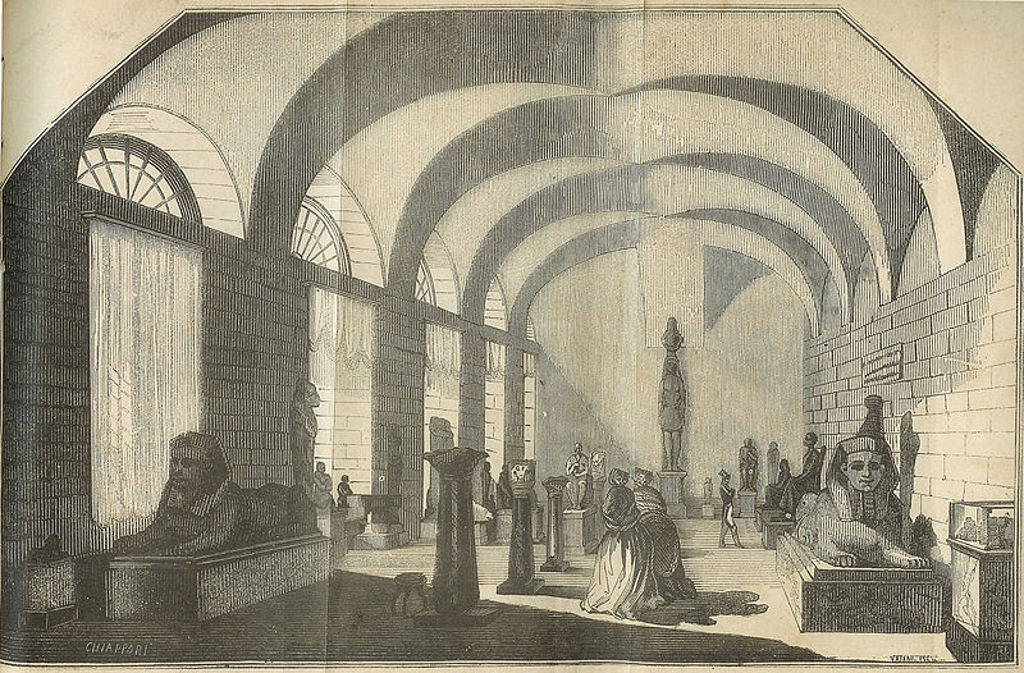
The room depicted, with its cross vaults and high windows, is clearly the Museo Egizio’s original monumental statue room, the Statuario.14 Some of the items reproduced in the engraving are clearly recognizable, such as the colossus of Sethi II at the back, the seated Ptah and the two colossal sphinxes arranged on either side of the room (Fig. 2).15
The Statuario in the 1990s. The sphinxes and the statue of Sethi II at the back are still in the same position as in 1851, while the seated Ptah, of white limestone, is now positioned along the left wall. Photo Museo Egizio/Giacomo Lovera.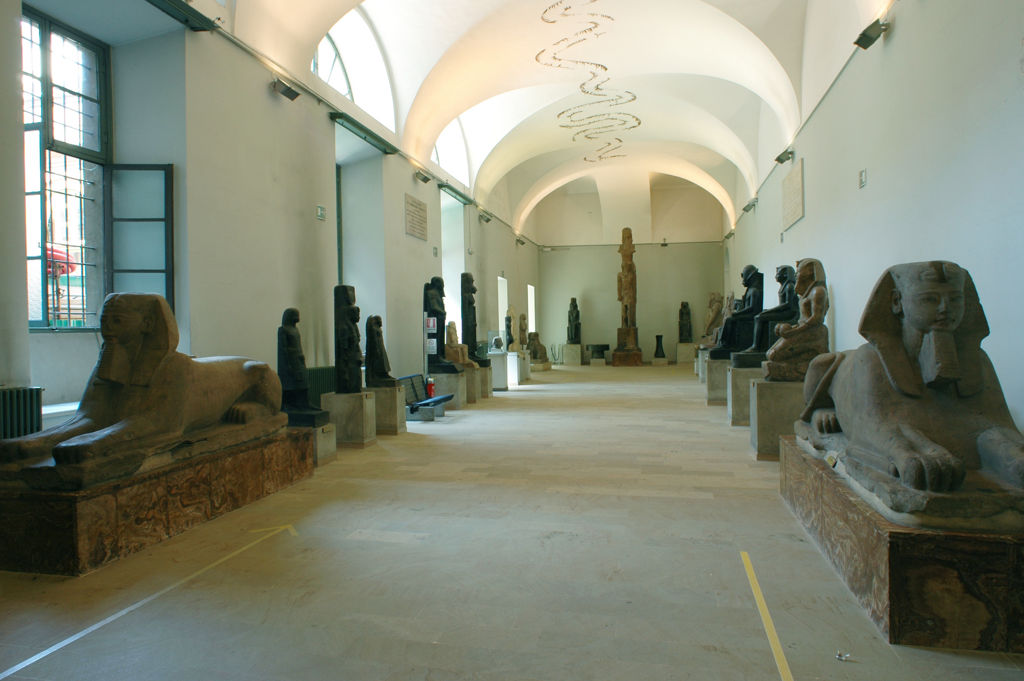
These last constituted the turning point of the investigation. Due to their size and position on either side of the room, they should have been detectable in the above-mentioned plan of the Statuario. This assumption turned out to be correct. The two largest rectangles in the left room of the plan align across the room and clearly indicate the two sphinxes. (Pl. 6) They are numbered 15 and 16. Therefore, it follows that the sphinxes are numbered in the “catalogo provvisorio” as 15 and 16.
Research in the Turin Archivio di Stato was very fruitful and also revealed the presence of another interesting document. Among the papers of the Archivio di Stato deposited by the Museo Egizio, I detected a hitherto overlooked inventory (henceforth “Inventario X”) consisting of 14 handwritten booklets listing 5230 Egyptian objects.16 The first page of each booklet bears the written title “Descrizione degli oggetti Egiziani” and specifies the numeric range of the items listed in the booklet (Table 1). In most cases, the final number listed for each range is contained in the next booklet: for example, although the cover of booklet 1 says that it contains objects 1–172, it actually contains objects 1–171; no. 172 is in booklet no. 2.
Booklet no.
Objects from number
Objects to number
Notes
1
1
172
2
172
450
3
450
738
The number 738 was written in to replace an original number that is no longer readable.
4
738
1024
The booklet contains objects 738-1022.
5
1023
1701
The number 1701 was written in to replace the original number 1698. We read in the last page of this booklet: “Aggiungi: No 1699 e 1700 che sono in tutto simili”.
6
1701
2181
7
2181
2603
8
2603
3001
9
3001
3377
The number 3377 was written in to replace the original number 3379.
10
3377
3755
11
3755
4157
12
4157
4542
Object number 4542 is included.
13
4543
4871
14
4871
5230
The number of items listed in Booklet no. 1 (Pl. 7) corresponds to the number of objects displayed in the plan in “Situazione”.17 Therefore, I assumed that this booklet could be related to this plan. In order to verify this assumption, I checked the items listed as numbers 15 and 16 of “Inventario X”. Object number 15 is a “Sfinge simile in tutto al N. 16. Manca solo il serpentello in fronte stato rotto”,18 while object number 16 is a:
These are 2.94 m in length (Pl. 8)
The identification of numbers 15 and 16 of “Inventario X” with the two colossal sphinxes depicted in the engraving is thus beyond question.
In order to verify the hypothesis of a link between the plan and the first booklet of “Inventario X”, I identified other objects that could be recognized with certainty in the engraving – namely the colossal statue of Sethi II and the seated statue of the god Ptah– in the plan, and checked the description of the corresponding numbers in “Inventario X”.
The colossal statue of Sethi II is labelled number 1 in the plan and the seated statue of the god Ptah is labelled number 18. Number 1 of “Inventario X” is described as:
Number 18 of “Inventario X” is “Ptah seduto. Manca il capo” (Pl. 8).21 It clearly emerges that these descriptions correspond to the statues identified.
Thus, it follows that the objects are labelled in the plan with the number assigned to them in “Inventario X”. The latter also includes an additional column titled “No del catalogo ragion.o”, referring to a permanent catalogue numbering system. This column was never filled in, but confirms that “Inventario X” – called “provisional” in the “Situazione” document – was a provisional catalogue preliminary to a permanent one. Further additions were made in pen or pencil on the document (Pls. 8–9).
Therefore, it is possible to certainly state that “Inventario X” is the “catalogo provvisorio” labelled as column C in the lists of correspondences (Pls. 3–5).
My identification and analysis of “Inventario X”, combined with searches in the internal database of the Museo Egizio and a study of the plan and of the list of concordances allowed me to identify certain of the items displayed in the Statuario in the 1850s and locate them in the plan (Table 2). It would indeed now be possible, by identifying all the items in the plan, to reconstruct the Museo Egizio’s Statuario as it was in the 1850s.
The items in “Inventario X” identified so far
N.o d’Inventario (Inventario X Number)
Altezza (Height)
Descrizione (Description of the object)
Corresponding Item
Number in “Situazione” (location of the object in the plan)
1
–
Statua colossale d’uomo in piedi, la gamba sinistra avanti in atto di camminare. Sul capo la parte posteriore dello pschent con penna ed ureus in fuori della penna ad ambi i lati. Sulla fronte il serpentello. Nella mano destra pendente un scettro corto: nella sinistra sostiene un alto bastone rotto all’estremità. Sulla faccia anteriore del piedistallo, sulle due laterali, sull’anteriore di tutto il bastone, vi sono iscrizioni geroglifiche. Vi si trova il cartello.
Cat. 1383
97
2
1.68
Statua d’uomo seduto. I capelli gli si allargano, e pendono da ambe le parti sul petto. Colla destra impugna uno scettro corto, la sinistra è distesa, ambi sulle coscie. Nella parte anteriore della sedia accanto alle gambe, due colonne perpendicolari d’iscriz. geroglifica. Alla sinistra leggesi il cart. No. di Ch.
Cat. 1374
91
3
2.4
Statua d’uomo in piedi con la gamba sinistra avanti in atto di camminare. I capelli gli pendono sul principio del petto. Ha lunga barba intrecciata. Le mani pog. distese sopra una veste che dalla cintura gli giunge sin presso alle ginocchia.
Cat. 1381
90
4
1.79
Statua d’uomo seduto. Sul capo ha un cimiero basso: sulla fronte il serpentello. Nella mano destra sostiene un bastone uncinato, colla sinistra posata sulla coscia impugna uno scettro corto sulla parte anteriore che discende dalle ginocchia una linea perpendicolare d’iscrizione geroglifica. Dietro alla gamba destra una piccola statua d’uomo tenente in mano una gran penna: dietro alla sinistra una statua di donna con disco e corna sul capo. Dietro ad ambe vi sono geroglifici e segnatamente dietro alla sinistra il cartello N. di Champ.
Cat. 1380
89
5
1.9
Statua d’uomo seduto. I capelli gli allargano e pendono da ambe le parti sul petto: ha il serpentello in fronte e le mani distese sulle coscie. La veste dalla cintura giunge alla metà delle coscie. Sulla parte anteriore della sedia accanto alle gambe vi sono due colonne perp. d’iscriz. ed in essa il cart. No. di Champ.
Cat. 1376
59
6
1.52
Statua d’uomo inginocchiato e seduto sulle calcagna. Ha sulla fronte l’Ureus, i capelli si allargano e discendono sul principio del petto. Colle mani sostiene due grosse palle che han somiglianza colla melagrana.
Cat. 1375
69
7
0.9
Uomo a destra e donna a sinistra seduti su d’una sedia comune. Colle due braccia di mezzo s’abbracciano – l’uomo ha i capelli dietro alle spalle, la donna divisi sul seno. Sulla veste hanno una linea perpendicolare di iscriz. geroglif. La sedia ne è coperta sulle due faccie laterali, e sulla posteriore. Sul davanti in mezzo ai due una linea perpendicolare di gerogl.
Cat. 3053
79
8
2.06
Testa colossale d’uomo. Sul capo un alto cimiero. Essa ha sulla fronte l’indizio del serpentello che manca per rottura.
Cat. 1387
87
9
0.59
Statua d’uomo in piedi colla gamba sinistra avanti in atto di camminare: una veste legata alla cintura giunge a più della metà delle coscie: sul capo l’ornamento detto parte posteriore dello pschent con penne ai due lati, e due ureus in fuori delle penne nella destra uno scettro a forma di chiave, colla sinistra tiene pei capelli uno schiavo.
Cat. 1392
36
10
1.13
Statua d’uomo in piedi la gamba sinistra av. in atto di camminare, i capelli pendono sul petto: il serpentello sulla fronte: nella mano destra la croce a manico: nella sinistra uno scettro corto: la veste è dalla cintura alle ginocchia.
Cat. 1384
23
11
0.56
Busto e capo di statua di donna in piedi sul capo un berretto di forma conica rovesciata con punta alta dietro, ma rotta, i capelli pendono sul seno. Sulla faccia posteriore della lapide alla quale s’appoggia una scoltura, e sotto sette linee d’iscrizioni geroglif. perpend. in parte mancanti per rottura della pietra.
Cat. 769
111
12
0.45
Testa e busto di donna. Sul capo l’indizio dello sparviero rotto: in fronte tre serpentelli: i capelli pendenti parte dietro alle spalle e parte sul seno.
Cat. 1385
122
13
1.48
Guerriero in atto di camminare colla sin. avanti, colle mani distese all’ingiù della veste. Ha i capelli a piccole treccie e a denti dietro alle spalle una pelle col capo di leone o gatto sul petto alla destra (?) un quadretto appeso con tre lastre alla cintura la veste copre tutto alle ginocchia.
Cat. 1377
71
14
0.38
Testa colossale d’uomo. Un nastro gli fascia la fronte sopra ha il serpentello.
Cat. 1396
31
15
2.94
Sfinge simile in tutto al N. 16. Manca solo il serpentello in fronte stato rotto.
Cat. 1408
125
16
–
Sfinge colossale a faccia d’uomo con lunga barba. Essa è nell’attitudine d’un animale di riposo ed attenzione. Sono alquanto rotti il naso, e i capelli dalla parte destra. Vi ha l’indizio che avesse il serpentello in fronte il quale manca totalmente.
Cat. 1409
86
17
0.28
Sfinge.
Cat. 1412
16
18
0.9
Ptah seduto-Manca il capo.
Cat. 87
142
19
2.05
Statua d’uomo seduto sopra una sedia e le mani sulle ginocchia. Sul capo ha un berretto rotondo sul quale si alzano due grandi penne, ha la barba attortigliata, una veste che dalla cintura va sino alle ginocchia colla sinistra impugna la chiave a manico. Sulla faccia anteriore della sedia accanto alle gambe vi sono due linee perpendicolari di iscrizione geroglifica nella quale si trovano i cartelli N.o di Champ. Gli stessi cartelli si trovano scritti sopra una specie di parete accanto al capo. Alla sua sinistra sta in piedi ed in atto di camminare un uomo che lo abbraccia col braccio destro. Questi ha i capelli che si allargano, e cadono sul principio del petto, la veste dalla cintura gli giunge sopra alle ginocchia. Colla sinistra impugnava uno scettro corto.
Cat. 768
1
The Statuario’s virtual reconstruction
The abovementioned results of the archival research will allow a multidisciplinary team of the Scuola Normale Superiore to create a digital reconstruction of the Statuario as it was in the 1850s. In autumn 2018, starting from the plan in “Situazione” (Pl. 6), the team used an open-source software to create a virtual reconstruction of one room of the Statuario.22 They set the plan as a background image in top view, then created a wireframe of the walls, added textures and furnished the room with some statue bases based on the 1851 engraving23 (Fig. 3a). The team then made 3D models of the objects24 identified so far (Figs. 3b–3c) and placed them in their original location within the room.
a: Virtual reconstruction of the room based on the plan (Pl. 6) and on the engraving (Fig. 1). ©Giuseppe Rignanese.
Due to the absence of measurements in the plan, while the room is such as it appears in the plan itself, its proportions are unlikely to be fully accurate. In the Biblioteca Reale in Turin, however, I found a document that allowed us to make up for this shortcoming. It contains eleven hand-drawn architectural plans of the Palazzo dell’Accademia delle Scienze produced in 1837,25 including one of the ground floor26 (Fig. 4). Using the measurements indicated in this plan, it is possible to produce an accurate virtual reconstruction of the statue gallery27 (Figs. 5–8). The work is still in progress and the 3D reconstruction forthcoming.28
Atlante del Palazzo dei Regii Musei, Turin 1837. Architectural plan of the ground floor. © Biblioteca Reale, Torino.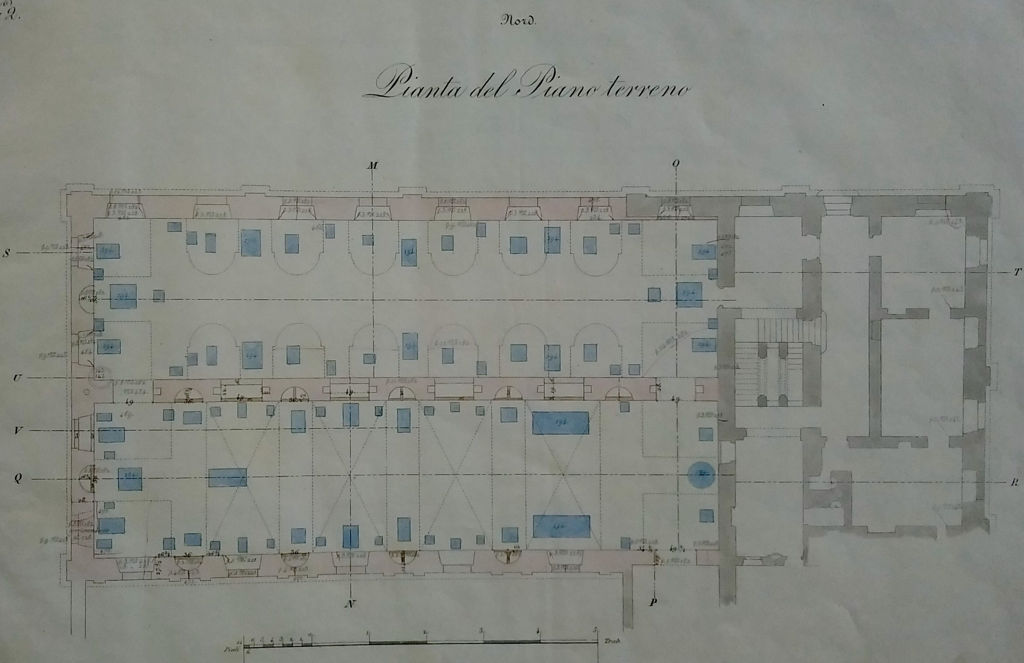
3D reconstruction of the Statuario based on its architectural plan. Detail of the vaults. ©Giuseppe Rignanese.
3D reconstruction of the Statuario based on its architectural plan. Detail of the building. ©Giuseppe Rignanese.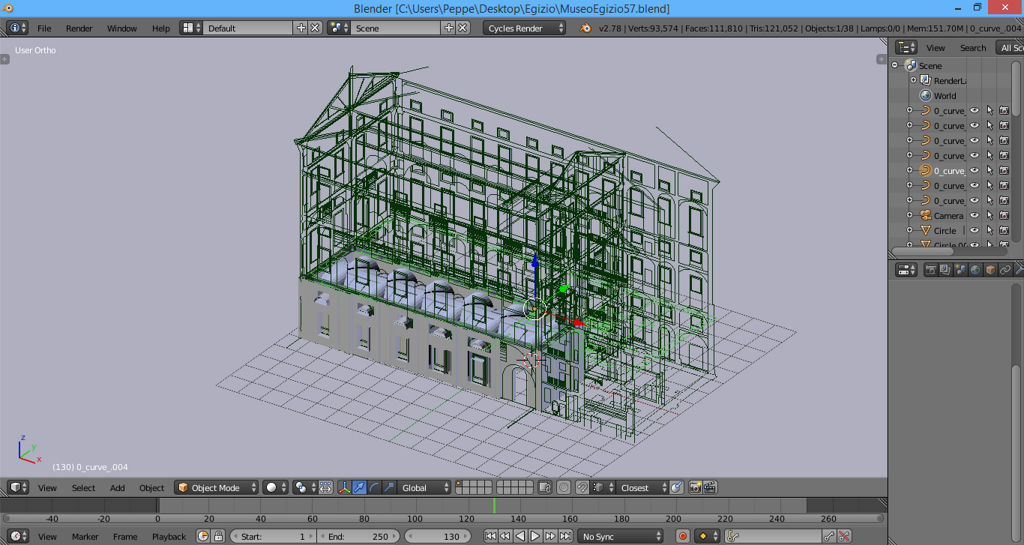
3D reconstruction of the Statuario based on its architectural plan. Detail of the building. ©Giuseppe Rignanese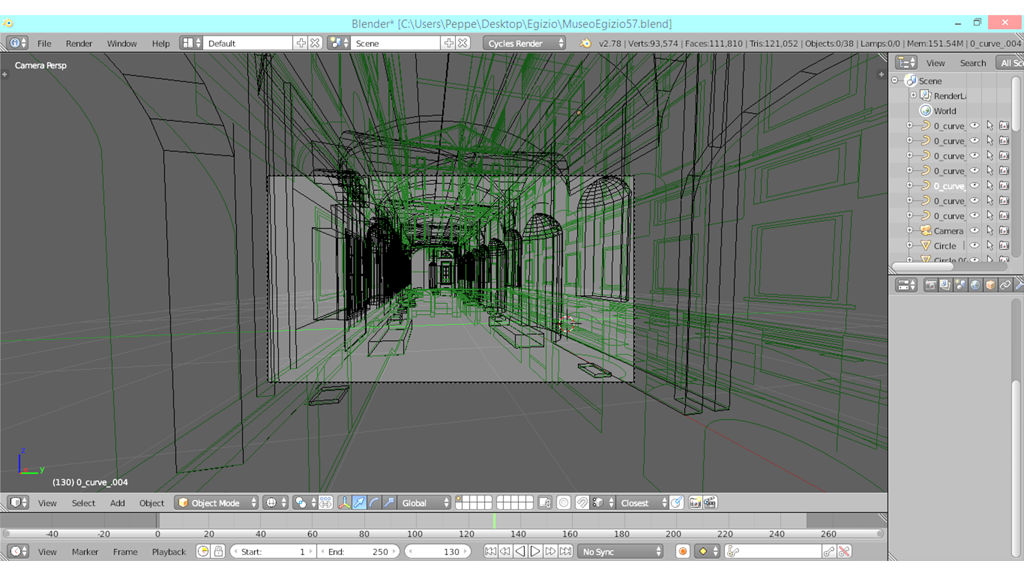
3D reconstruction of the Statuario based on its architectural plan. Detail of the room. ©Giuseppe Rignanese.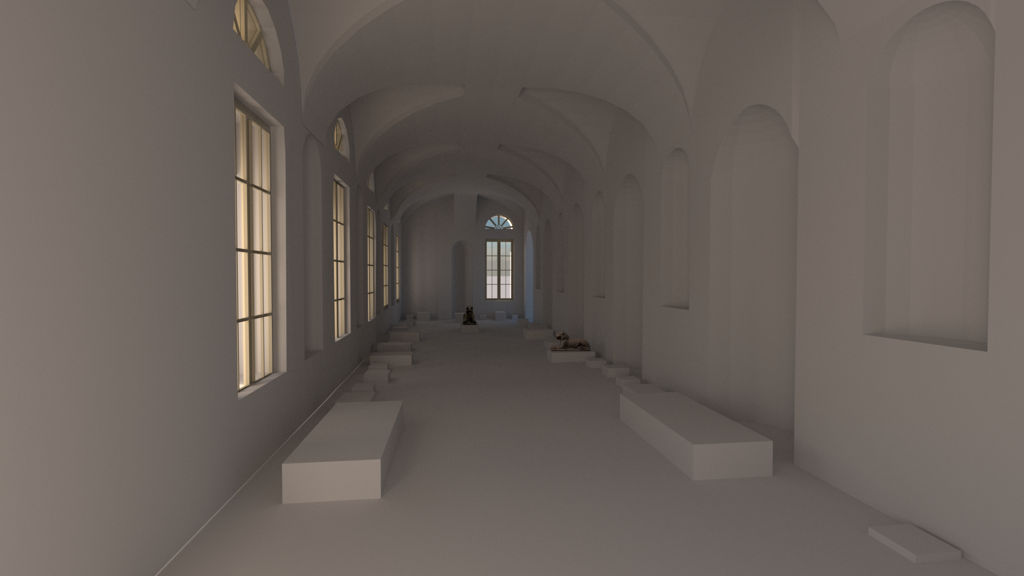
The analysis of the architectural plan of the Statuario also highlighted the presence of 84 geometrical forms – mostly rectangles and squares – neatly arranged and painted in blue. These undoubtedly indicate the bases of the objects displayed, a hypothesis further confirmed by the presence of the bases of the two sphinxes on opposite sides of the room that are visible on the lower right of the plan.
By comparing the architectural plan with the plan in “Situazione” it clearly emerges that the objects displayed in the Statuario in 1837 may have been fewer in number than the objects displayed in the 1850s. The lower number of the items indicated in the architectural plan might reflect the real disposition in 1837 or might be due to the nature of the document, namely a neat architectural plan where items considered as superfluous were omitted to avoid clutter. Only further research can confirm or refute these hypotheses.
Finally, the 1850s sketch is not a unicum
Therefore, thanks to the “Situazione” and to the Moiso map, we are now able to retrace at least four different layouts of the Museo Egizio’s Statuario, including the current one.
The first room of the Statuario on January 17th, 1974. ©Beppe Moiso.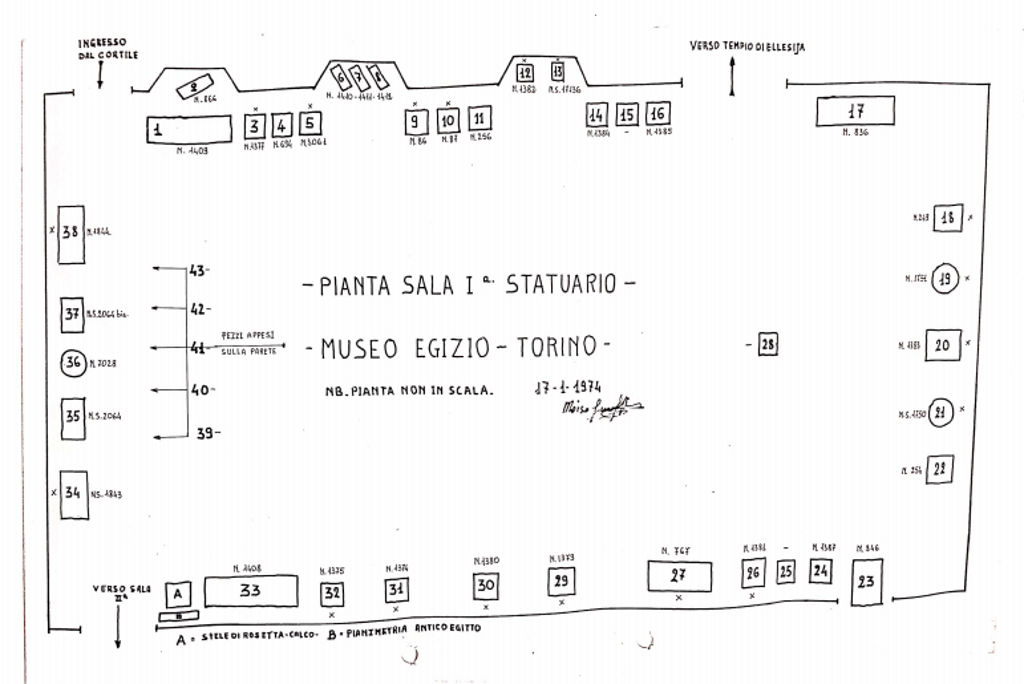
The second room of the Statuario on January 19th, 1974. ©Beppe Moiso.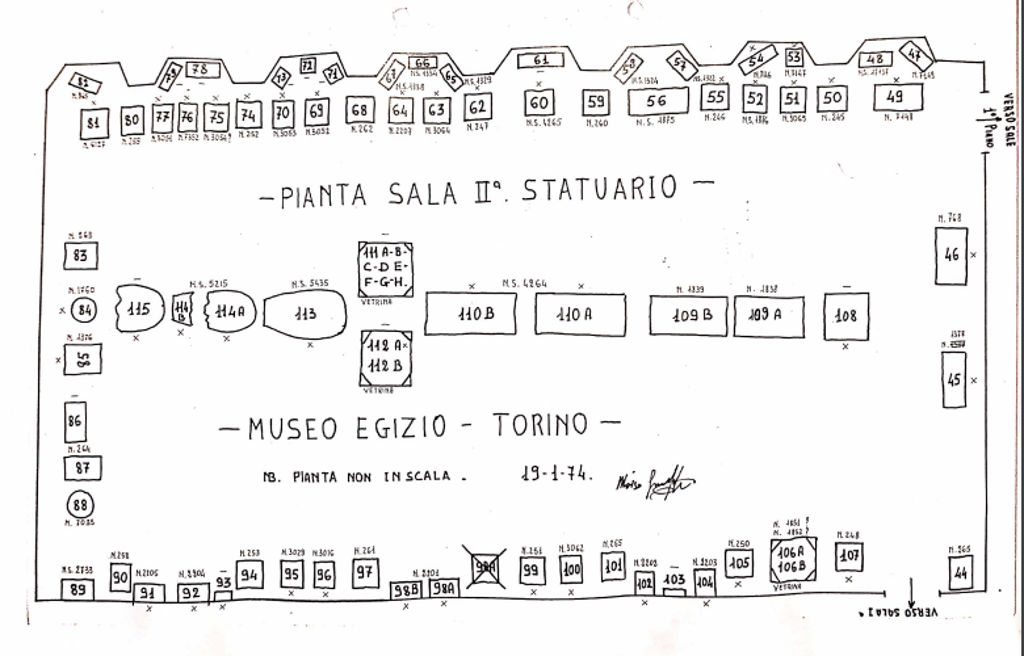
Conclusion
The above-discussed documents highlight the importance of archival research for a better knowledge of the history of the Museo Egizio. Future objectives should include identifying all the objects listed in the first booklet of “Inventario X” and locating them in the plan; studying and virtually reconstructing the rooms of the Statuario in the 1850s; creating 3D models of the objects displayed in them in the 1850s and placing them in their original position within the virtually reconstructed room; virtually reconstructing the 1974 display of the Statuario; creating a time-lapse video of the evolution of the Statuario over the years; and producing interactive applications in order to present the research results to a broader audience.30
Appendix: The folder “Inventario minuto delle Antichità Egizie. Monumenti al Pian Terreno”
The folder “Inventario minuto delle Antichità Egizie. Monumenti al Pian Terreno” consists of three handwritten documents, for a total of 32 pages with their numbers pencilled on the bottom right side of the paper:
- “Situazione dei monumenti egiziani delle sale al pian terreno. I numeri sono quelli dati a ciascun monumento nel catalogo provvisorio” (Disposition of the Egyptian monuments displayed on the ground floor. Each monument is numbered as in the provisional catalogue). (Pls. 2–6). Turin, Archivio di Stato, MAE 2° vers., M2, no. 24, 1–4;
- “Inventario minuto delle antichità egizie. Monumenti al pian Terreno” (Detailed inventory of the Egyptian antiquities. Monuments displayed on the ground floor). Turin, Archivio di Stato, MAE 2° vers., M2, no. 24, 5–10) (Pl. 10);
- “Inventario dei monumenti Egizi delle Sale a pian Terreno” (Inventory of the Egyptian monuments displayed on the ground floor). Turin, Archivio di Stato, MAE 2° vers., M2, no. 24, 11–28) (Pls. 11–13).
Document 1 (“Situazione”) is thoroughly analysed in the main text of this article.
Document 2, as its name already suggests, is an inventory indicating the dimensions (length, height), material, original collection, and description of the objects, which are listed in a continuously numbered sequence.
Document 3 is also an inventory, indicating the dimensions (length, height), material and description of the listed objects. However, unlike the previous list, the items are here divided in groups31 designated by the letters of the alphabet, except for the group “Monumenti Greco-Egizi”32:
Page 24 is characterized by the addition in pencil of three further groups of items on its left side:
- “Monumenti Romani”
- “Monumti Assiri”
- “Monti Sardi”.38
The two inventories bear almost identical titles and Document 2 and the groups A-D of Document 339 present the objects in the same order and described with almost the same words. To offer one example, the first item listed in Document 2 is a “Statua del dio Phtah [sic] ritto col Nilometro”, a standing statue of the god Ptah with a “Nilometer” (a djed pillar)40 in black granite, 2.0 m in height and 0.75 m in width41 (Fig. 11a) while the second is the “Statua del medesimo sedente col Nilometro ristorata nel capo”, a seated statue of the same god in white limestone, also holding a “Nilometer” and with a restored head, 1.2 m in height and 0.72 m in width (Fig. 11b).42 The standing statue of the god Ptah in black granite is also listed first in Document 343 and is likewise followed by the seated statue of the same god in white limestone with a restored head. They are respectively described as “Statua d’uomo ritto con Nilometro, Ptah con iscrizione” with the addition underneath in pencil “forgiato come mummia” (mummiform) and “Statua d’uomo sedente col Nilometro, Ptah, ristorato nel capo”.44 The same goes for the remaining
a: Statue of Ptah, Museo Egizio Cat. 86. Photo by Museo Egizio.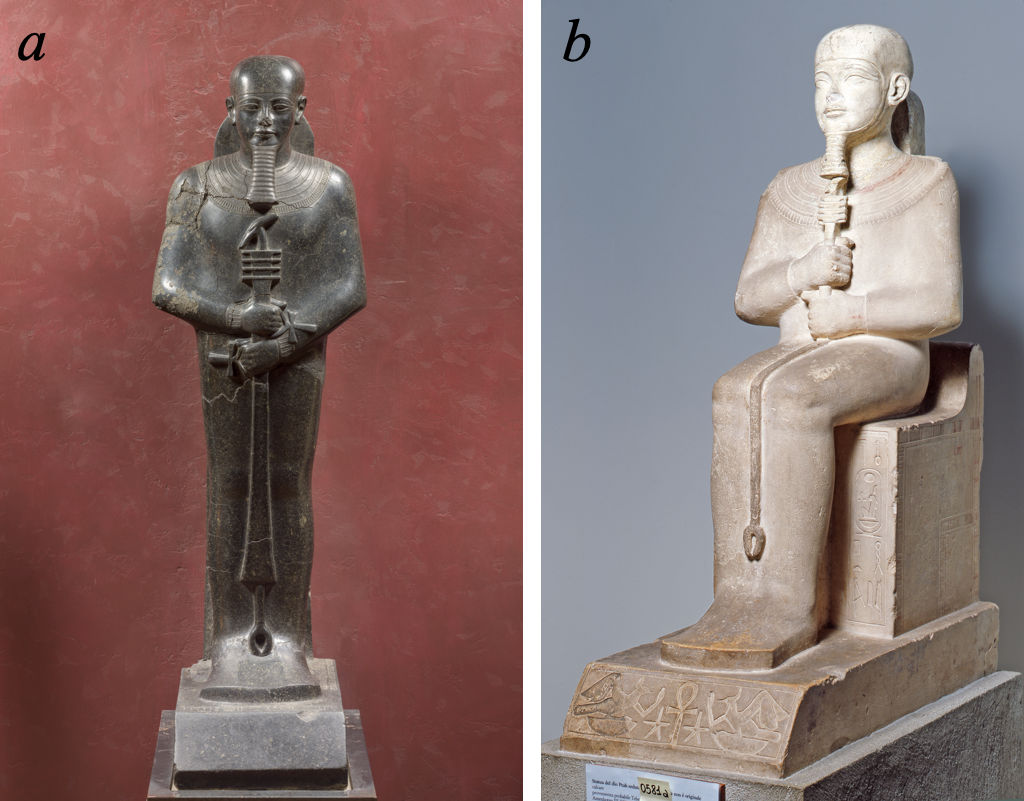
Careful study of these documents combined with a study of the printed catalogues of the Museo Egizio allowed me to confirm this hypothesis and to identify a catalogue characterized by the division into groups which distinguishes Document 345 and in which the objects are listed following the same order as in the drafts.46 The handwritten documents held in the Archivio di Stato thus turned out to be preparatory work for the Catalogo Illustrato dei Monumenti Egizii, Sala al Pianterreno published in 1852 by Pier Camillo Orcurti.47
A well-defined link between Documents 2 and 3 and the plan and lists of the “Situazione” document— which were all stored together within the folder “Inventario minuto delle Antichità Egizie. Monumenti al Pian Terreno”48 — was impossible to prove.
The objects listed in the “Situazione” plan and in the two inventories (Documents 2 and 3) differ in number. The plan shows 172 objects (Pl. 6)49 while Document 2 lists 165.50 Groups A to D of Document 3 – namely those items that correspond to the objects listed in the Orcurti catalogue and in Document 2 – enumerate instead 175 items51 and additional numbers are written in pen or pencil on the right side of the paper (Pl. 15). Document 3 is also characterized by a further 42 objects divided into five categories labelled A to E52 and 75 items written in pencil, plausibly at a later time. Furthermore, in Document 3 the items displayed on the ground floor are grouped in the abovementioned four categories A to D, while the third column of the second list of correspondences is characterized by twelve categories, labelled A to N (Pls. 4–5).
The documents held in the folder thus show inconsistent numberings, with the consequence that it is not possible to link the objects mentioned in the inventories with the numbers indicated in the plan. As a result, none of these documents provide a complete understanding of how the Statuario objects were numbered in the “catalogo provvisorio”. The additional numberings of Document 354 may constitute a previous, failed attempt to link this inventory to the plan and to the lists of correspondences.
Bibliography
Moiso, Beppe, La Storia del Museo Egizio, Modena 2016.
Orcurti, Pier Camillo, Catalogo Illustrato dei Monumenti Egizii del R. Museo di Torino. Sale al Piano Terreno, Torino 1852.
Orcurti, Pier Camillo, Catalogo Illustrato dei Monumenti Egizii del R. Museo di Torino. Sale al Quarto Piano, Torino 1855.
Petrino, Carbonassi and Pernigotti, Atlante del Palazzo dei Regii Musei, Torino 1837.
Stefani, Guglielmo and Domenico Mondo, Torino e Suoi Dintorni. Guida Storico-Artistica, Amministrativa e Commerciale, Torino 1852.
Online sources
L’Archivio del Museo Egizio di Torino: https://archiviodistatotorino.beniculturali.it/naviga-patrimonio/progetti/archivio-museo-egizio-torino/
Archivio della Soprintendenza Speciale al Museo delle Antichità Egizie: https://archiviodistatotorino.beniculturali.it/upload/museo-egizio.pdf
Museo Egizio di Torino 2vers: https://archiviodistatotorino.beniculturali.it/upload/museo-egizio-2vers.pdf
Cover of the folder Inventario minuto delle Antichità Egizie. Monumenti al Pian Terreno. Archivio di Stato di Torino.
Sheet 1,1 of Situazione dei monumenti egiziani delle sale al pian terreno. I numeri sono quelli dati a ciascun monumento nel catalogo provvisorio. Archivio di Stato di Torino.
Sheet 2,2 of Situazione dei monumenti egiziani delle sale al pian terreno. I numeri sono quelli dati a ciascun monumento nel catalogo provvisorio. Archivio di Stato di Torino.
Sheet 2,3 of Situazione dei monumenti egiziani delle sale al pian terreno. I numeri sono quelli dati a ciascun monumento nel catalogo provvisorio. Archivio di Stato di Torino.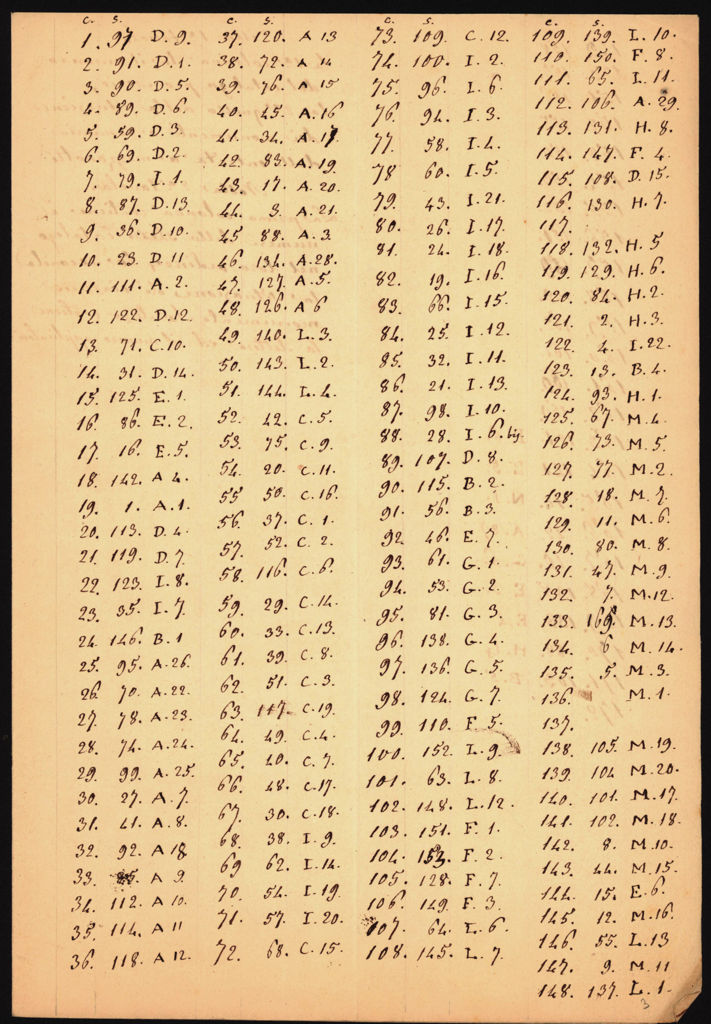
Sheet 2,3b of Situazione dei monumenti egiziani delle sale al pian terreno. I numeri sono quelli dati a ciascun monumento nel catalogo provvisorio. Archivio di Stato di Torino.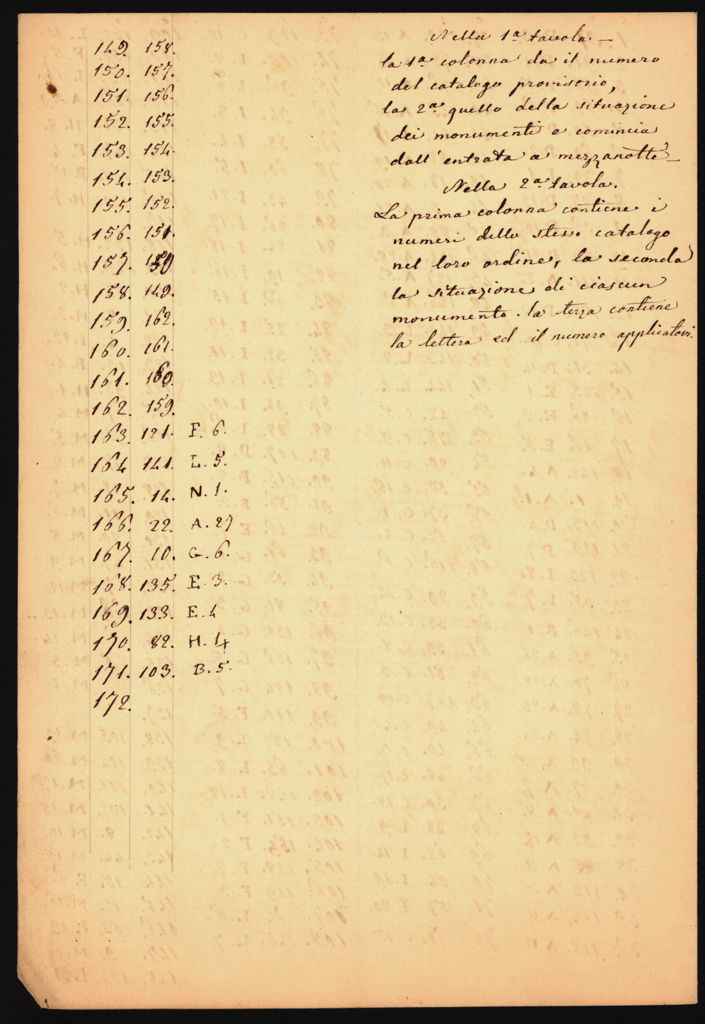
Sheet 1,4 of Situazione dei monumenti egiziani delle sale al pian terreno. I numeri sono quelli dati a ciascun monumento nel catalogo provvisorio. Archivio di Stato di Torino.
Cover of Inventory X’s first booklet. Archivio di Stato di Torino.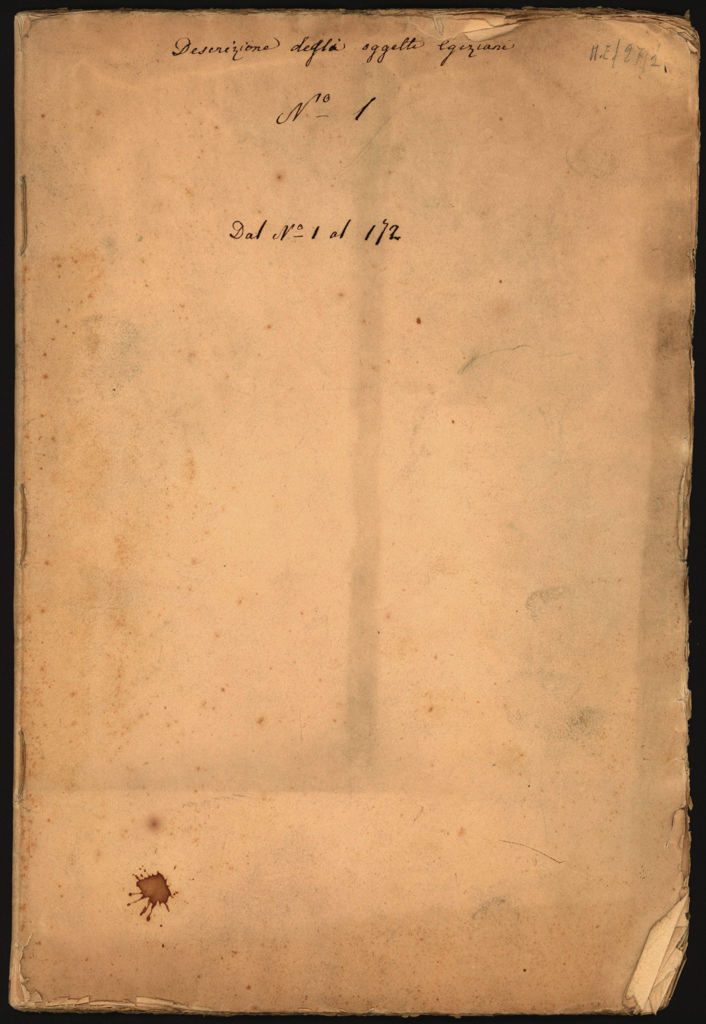
Page 2 of Inventory X’s first booklet. Archivio di Stato di Torino.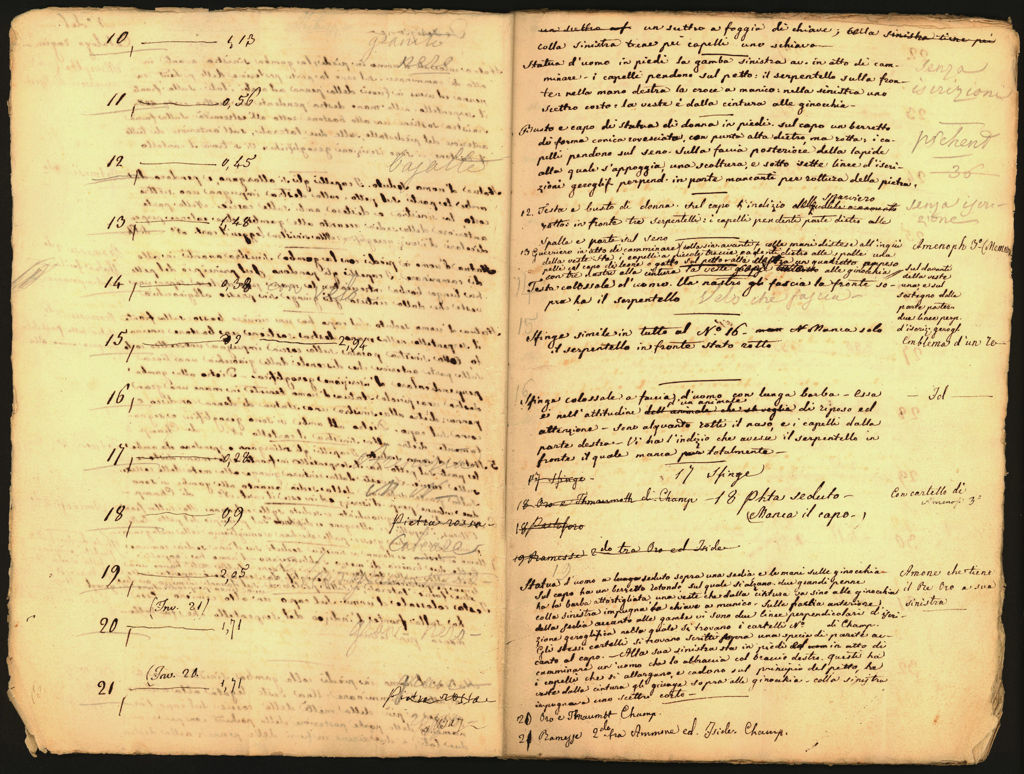
Page 1 of Inventory X’s first booklet. Archivio di Stato di Torino.
Page 1 of Inventario minuto delle antichità egizie. Monumenti al pian Terreno. Archivio di Stato di Torino.
Page 1 of Inventario dei monumenti Egizi delle Sale a pian Terreno. Archivio di Stato di Torino.
Page 2 of Inventario dei monumenti Egizi delle Sale a pian Terreno. Archivio di Stato di Torino.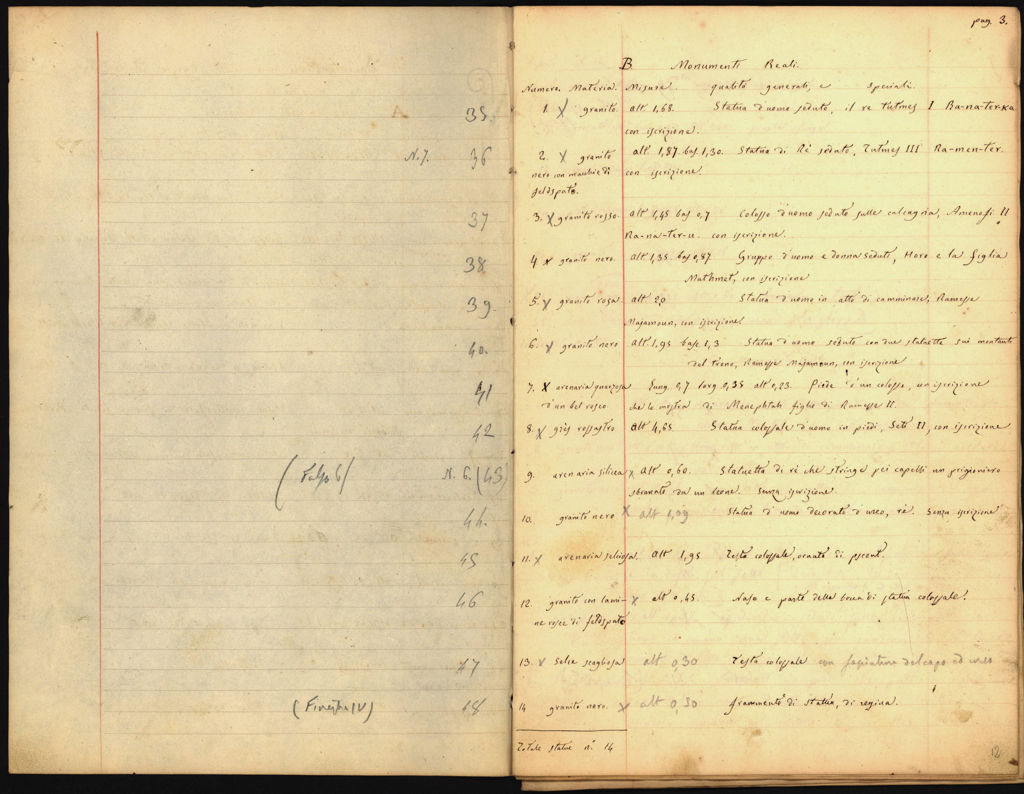
Page 4 of Inventario dei monumenti Egizi delle Sale a pian Terreno. Archivio di Stato di Torino.
Page 10 of Inventario minuto delle antichità egizie. Monumenti al pian Terreno. Archivio di Stato di Torino.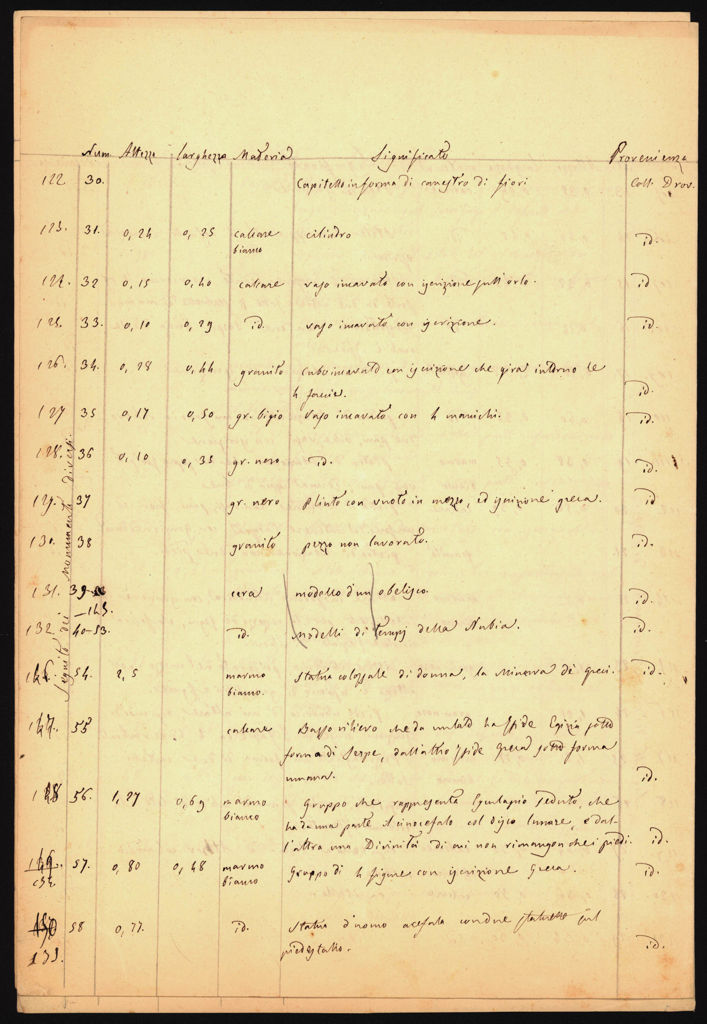
Page 12 of Inventario dei monumenti Egizi delle Sale a pian Terreno. Archivio di Stato di Torino.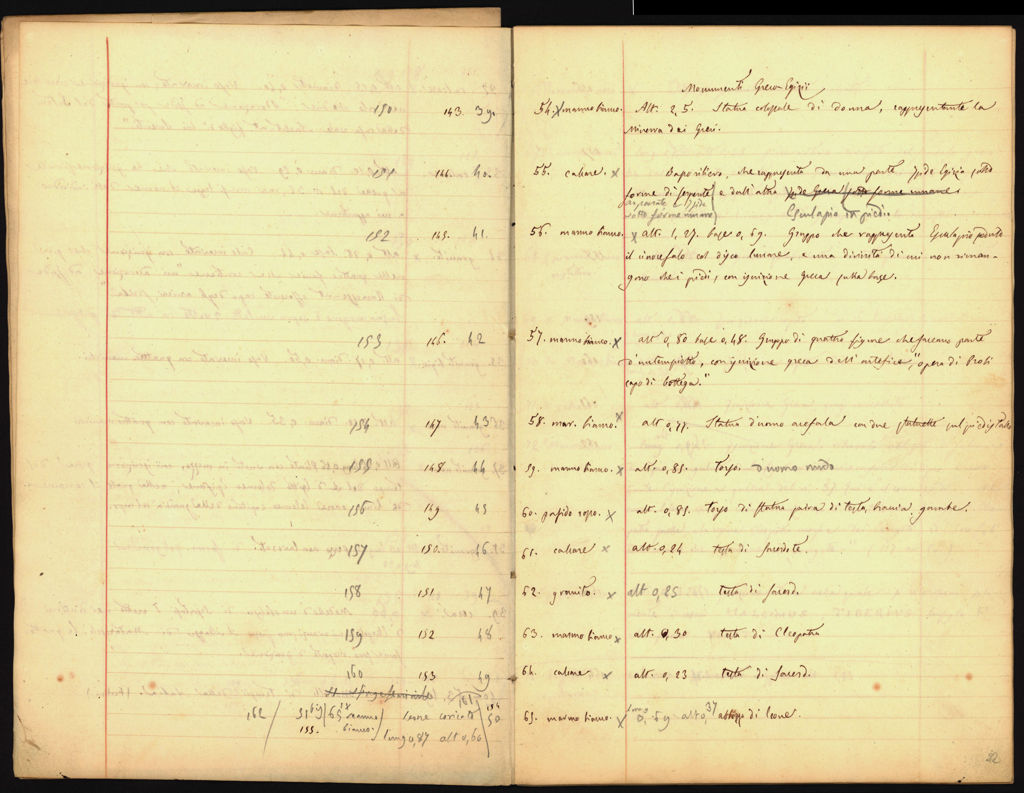
Notes
- I am very grateful to Luigi Prada (University of Oxford/University of Uppsala) and Paul Stanwick (Institute of Fine Arts, New York University) for the time spent revising the English version of this paper, which greatly benefitted from their contributions.↑
- <a href="https://archiviodistatotorino.beniculturali.it/upload/museo-egizio-2vers.pdf">Museo Egizio di Torino 2vers</a>, 1, 8, 11. A first group of documents was transferred from the Museo Egizio to the Archivio di Stato di Torino by the Soprintendenza per i Beni Archeologici del Piemonte e del Museo di Antichità Egizie as early as 2005 (<a href="https://archiviodistatotorino.beniculturali.it/upload/museo-egizio.pdf">Archivio della Soprintendenza Speciale al Museo delle Antichità Egizie</a>).↑
- I began investigating the main archives and libraries in Turin as part of the collaborative project “Dalla Corte all’Università. Le Collezioni di Antichità a Torino e il Regio Museo d’Antichità (1723-1832)” (From the Court to the University. The Antiquities Collections in Turin and the Regio Museo d’Antichità [1723-1832]), whose aim was to study one of the many phases in the history of the antiquities collections that were eventually absorbed, fully or partly, into the Museo Egizio—namely, the Regio Museo d’Antichità (1723-1832). The aim of the abovementioned archival research was to detect unpublished inventories and documents related to the Regio Museo d’Antichità’s items. I would like to thank the Principal Investigator of the project, Professor Gianfranco Adornato (Scuola Normale Superiore), the Director of the Museo Egizio, Christian Greco, and Museo Egizio curators Beppe Moiso and Federico Poole for their continuous support and invaluable assistance.↑
- “Detailed inventory of the Egyptian antiquities. Monuments displayed on the ground floor”. Turin, Archivio di Stato, MAE 2° vers., M2, no. 24.↑
- On the identification of the documents held in the folder, see the Appendix.↑
- Disposition of the Egyptian monuments displayed on the ground floor. Each monument is numbered as in the provisional catalogue. Turin, Archivio di Stato, MAE 2° vers., M2, no. 24, 1–4.↑
- Turin, Archivio di Stato, MAE 2° vers., M2, no. 24, 2–3.↑
- Turin, Archivio di Stato, MAE 2° vers., M2, no. 24, 4.↑
- “L’Archivio del Museo Egizio di Torino” and “Archivio della Soprintendenza Speciale al Museo delle Antichità Egizie”.↑
- In 2019, labels showing inventory numbers consisting of a letter followed by a number were still attached to some items.↑
- “In the first table, the first column indicates the provisional catalogue numbers, the second the position of the monuments starting from the “midnight entrance”. In the second table, the first column indicates the numbers of the same catalogue in ascending order, the second the position of each monument, the third the letter and number assigned to it.” The tables in question are called “lists” in this article.↑
- “Mezzanotte” is old Italian for north. Number 19 of “Situazione” is located on the northern side of the room, that is, as said above, the Museo Egizio’s Statuario. The entrance to the north (entrata di mezzanotte) is also visible in the architectural plan of the Statuario made in 1837 (see note 25 and Fig. 4).↑
- Stefani and Mondo, <i>Torino</i>, 1852, p. 168.↑
- Its current appearance is due to its redecoration by Dante Ferretti in 2006, which has concealed both the vaults and the windows. The image is mentioned and identified as the Statuario by Moiso, <i>La Storia del Museo Egizio</i>, 2016, p. 119.↑
- Cat. 1383, Cat. 87, Cat. 1408 and Cat. 1409.↑
- "Descrizione degli oggetti egiziani", Turin, Archivio di Stato, MAE 2° vers., M2, no. 1.↑
- Booklet no. 1 and the plan list 172 items. List 1 includes 167 items while List 2 includes 171/172 items (the two columns linked to item 172 are actually empty).↑
- “Sphinx identical to item 16. Only the snake on the forehead is missing (broken).”↑
- Colossal sphinx with human head, long beard etc.↑
- The word “cartello” is used with the meaning of cartouche.↑
- We do know that the head of the seated Ptah (Museo Egizio, Cat. 87) was restored before 1852, that is when the Orcurti Catalogue was published. More precisely, we read in this publication “Statua d'uomo sedente col nilometro, ristorata nel capo; calcare bianco. Altezza 1, 2, base 0, 72. Rappresentano entrambe <i>[i.e., it and the statue mentioned before it in the catalogue, author’s note]</i> il dio Phtah etc.” (Orcurti, <i>Catalogo Illustrato</i>, 1852, p. 41).↑
- Using the open-source software Blender 2.78c <a href="https://www.blender.org/">https://www.blender.org/</a>. The virtual reconstruction of the room was made by Giuseppe Rignanese (Scuola Normale Superiore).↑
- Stefani and Mondo, <i>Torino</i>, 1852, p. 168.↑
- The 3D reconstructions were made by Dr Pietro Manti (Scuola Normale Superiore).↑
- Petrino, Carbonassi and Pernigotti, <i>Atlante</i>, 1837.↑
- Petrino, Carbonassi and Pernigotti, <i>Atlante</i>, 1837, p. 2. The architectural plan of the ground floor also clearly shows the “entrata di mezzanotte” to the north.↑
- The measurements are in <i>trabucchi</i>, an old Italian unit of measurement which differed from region to region. In Piemonte, a <i>trabucco</i> corresponded to 3.086 m.↑
- Detailed results of this multidisciplinary project are going to be published by the team. The current 3D model of the Statuario is without textures, which will be added in the final virtual reconstruction.↑
- I would like to thank Beppe Moiso for showing me these documents in December 2019 and authorising their publication in the present article.↑
- The team aims to achieve these goals by 2024, the bicentenary of the museum.↑
- Each group is characterized by numbering beginning from 1, while a continuous numbering is written in pencil on the right side of the left-hand page (Pl. 12). A second continuous numbering is written in pen alongside the group numbering starting from the second item listed from sheet 14 (Pl. 13) to sheet 23. Turin, Archivio di Stato, MAE 2° vers., M2, no. 24, 14–23.↑
- Graeco-Roman Monuments. Turin, Archivio di Stato, MAE 2° vers., M2, no. 24, 22–23.↑
- Religious Monuments. Turin, Archivio di Stato, MAE 2° vers., M2, no. 24, 11.↑
- Royal Monuments. Turin, Archivio di Stato, MAE 2° vers., M2, no. 24, 12.↑
- Civil Monuments. Turin, Archivio di Stato, MAE 2° vers., M2, no. 24, 13.↑
- Heterogeneous Monuments. Turin, Archivio di Stato, MAE 2° vers., M2, no. 24, 17.↑
- Mexican Monuments. Turin, Archivio di Stato, MAE 2° vers., M2, no. 24, 24.↑
- Roman Monuments, Assyrian Monuments, and Sardinian Monuments. Turin, Archivio di Stato, MAE 2° vers., M2, no. 24, 24. “Monumenti Romani” lists 7 items, “Monumti Assiri” 2 objects and “Monti Sardi” 5 items.↑
- Turin, Archivio di Stato, MAE 2° vers., M2, no. 24, 11–21.↑
- According to Orcurti, the object held by the god is a “Nilometer” (indicator of the Nile level) (Orcurti, <i>Catalogo Illustrato dei Monumenti Egizii</i>, 1852, p. 41) but actually it is the superimposed <i>djed</i> and <i>was</i> sceptres, “Nilometer” being a common old designation for the former.↑
- Turin, Archivio di Stato, MAE 2° vers., M2, no. 24, 5: “Num: 1; Altezza: metri 2,0; Larghezza: 0,75; Materia: granito nero; Significato: Statua del dio Phtah ritto col Nilometro; Provenienza: Col. Drovetti”. It corresponds to Turin, Museo Egizio Cat. 86.↑
- Turin, Archivio di Stato, MAE 2° vers., M2, no. 24, 5: “Num: 2; Altezza: metri 1,2; Larghezza: 0,72; Materia: calcare bianco; Significato: Statua del medesimo sedente col Nilometro ristorata nel capo; Provenienza: Col. Drovetti”. It corresponds to Turin, Museo Egizio Cat. 87.↑
- Turin, Archivio di Stato, MAE 2° vers., M2, no. 24, 11: “Numero: 1; Materia: granito nero; Misura: Alt 2,0 bas. 0,75; Qualità generali e speciali: Statua d’uomo ritto con Nilometro; Ptah: con iscrizione forgiata come mummia”.↑
- Turin, Archivio di Stato, MAE 2° vers., M2, no. 24, 11: “Numero: 2; Materia: calcare bianco; Misura: Alt 1,2, bas. 0,72; Qualità generali e speciali: Statua d’uomo sedente col Nilometro, Ptah, ristorata nel capo”.↑
- The catalogue is divided in four groups - A to D- which coincide with Groups A to D of Document 3 and with the objects listed in Document 2.↑
- Following the example above, the first item of this catalogue is described as “Statua d’uomo ritto col Nilometro, granito nero. Altezza 2,0, base 0,75” and the second object is a “Statua d’uomo sedente col nilometro, ristorata nel capo; calcare bianco. Altezza 1, 2, base 0,72” (Orcurti, <i>Catalogo Illustrato dei Monumenti Egizii</i>, 1852, p. 41).↑
- In 1855 Orcurti published a second volume on the items displayed on the fourth floor (Orcurti, <i>Catalogo Sale al Quarto Piano</i>, 1855).↑
- Turin, Archivio di Stato, MAE 2° vers., M2, no. 24.↑
- Turin, Archivio di Stato, MAE 2° vers., M2, no. 24, 2–4.↑
- Turin, Archivio di Stato, MAE 2° vers., M2, no. 24, 5–10. The numbering of Document 2 has been edited starting from number 146. Turin, Archivio di Stato, MAE 2° vers., M2, no. 24, 9b (Pl. 14)↑
- Turin, Archivio di Stato, MAE 2° vers., M2, no. 24, 11–24.↑
- Cf. above, note 30.↑
- Turin, Archivio di Stato, MAE 2° vers., M2, no. 24, 3.↑
- Cf. above, note 30.↑










